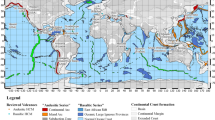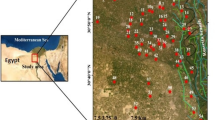Abstract
The Karst aquifers are usually characterized by high spatial heterogeneity in the humid tropics and subtropics, evidenced by specific landforms features (e.g., heavily fractured outcrops, sinkholes, etc.) and complex subterranean conduit networks. The marked high heterogeneity leads to the temporal–spatial variability of hydrological and hydro-chemical processes, making its environments extremely vulnerable to natural and anthropogenic hazards. The complicated temporal–spatial variability of hydrochemistry in karst systems depends on several underlying factors which influence the hydro-chemical processes. Investigating the factors of the karst water hydrochemistry variability is necessary to understand the hydro-chemical processes and mitigate natural and anthropogenic hazards for ensuring the sustainability of karst water resources. In this paper, an attempt is made to couple geostatistical and geochemical analysis to extract the underlying controlling factors and effective information about the geochemical evolution behave of karst water in Houzhai karst area, southwestern China. Factor analysis was performed to obtain significant statistical relationship of the hydrochemistry variation in the Houzhai karst basin. The ordinary kriging method was applied to the factor scores to investigate the contributions of factors on different regions. The results of the factor analysis indicated four principal factors which explained > 81.678% of the total sample variance: (1) the dilution effect by rainfall; (2) the dissolution effect dominated by calcite; (3) the human agricultural activities effect; (4) the migration of dissolved components under the control of alkaline environments in karst water. It revealed that the dilution effect was more significant (36.579%) than the dissolution effect (22.036%) and human agricultural activities effect (14.596%). These factors made more significant difference of contributions on the karst area in the dry periods than in the rainy periods. The dilution process by rainfall and the dissolution process of carbonate rock had a great influence on the upstream area whereas the human agricultural activities played important roles in the middle-stream area, especially in the dry periods. This integrated approach which combine factor analysis with kriging method is effective in the identification and interpretation of factors related to the variability of hydrochemistry, as well as the contributions of these factors on space and time.

modified from Liu et al. 2010)

modified from Liu et al. 2010)






Similar content being viewed by others
References
Bonacci O, Ljubenkov I, Knezic S (2011) The water on a small karst island: the island of Korčula (Croatia) as an example. Environ Earth Sci 66(5):1345–1357
Chen X, Zhang ZC, Soulsby C, Cheng QB, Binley A, Jiang R, Tao M (2018) Characterizing the heterogeneity of karst critical zone and its hydrological function: an integrated approach. Hydrol Process 32(19):2932–2946
Cloutier V, Lefebvre R, Therrien R, Savard MM (2008) Multivariate statistical analysis of geochemical data as indicative of the hydrogeochemical evolution of groundwater in a sedimentary rock aquifer system. J Hydrol 353(3–4):294–313
Dalton MG, Upchurch SB (1978) Interpretation of hydrochemical facies by factor analysis. Groundwater 16(4):228–233
Delbart C, Valdés D, Barbecot F, Tognelli A, Couchoux L (2016) Spatial organization of the impulse response in a karst aquifer. J Hydrol 537:18–26
Derakhshannia M, Dalvand S, Asakereh B, Ostad-Ali-Askari K (2020) Corrosion and deposition in Karoon River, Iran, based on hydrometric stations. Int J Hydrol Sci Technol 10(4):334–345
Dragon K, Górski J (2009) Identification of hydrogeochemical zones in postglacial buried valley aquifer (Wielkopolska Buried Valley aquifer, Poland). Environ Geol 58(4):859–866
Dragon K, Górski J (2015) Identification of groundwater chemistry origins in a regional aquifer system (Wielkopolska region, Poland). Environ Earth Sci 73(5):2153–2167
Golian M, Katibeh H, Singh VP, Ostad-Ali-Askari K, Rostami HT (2020) Prediction of tunnelling impact on flow rates of adjacent extraction water wells. Q J Eng Geol Hydrogeol 53(2):236–251
Güler C, Thyne GD (2004) Hydrologic and geologic factors controlling surface and groundwater chemistry in Indian Wells-Owens Valley area, southeastern California, USA. J Hydrol 285(1–4):177–198
Hartmann A, Barberá JA, Lange J, Andreo B, Weiler M (2013) Progress in the hydrologic simulation of time variant recharge areas of karst systems—exemplified at a karst spring in Southern Spain. Adv Water Resour 54(4):149–160
Hartmann A, Goldscheider N, Wagener T, Lange J, Weiler M (2015) Karst water resources in a changing world: review of hydrological modeling approaches. Rev Geophys 52(3):218–242
Hosseini SM, Ataie-Ashtiani B, Simmons CT (2017) Spring hydrograph simulation of karstic aquifers: impacts of variable recharge area, intermediate storage and memory effects. J Hydrol 552:225–240
Hu X, Chen B, He G (2001) Study on the model of rational land use in the karst areas of the Houzhai River Basin. Carsologica Sinica 20(4):305–309
Huang G, Sun J, Zhang Y, Chen ZG, Liu F (2013) Impact of anthropogenic and natural processes on the evolution of groundwater chemistry in a rapidly urbanized coastal area, South China. Sci Total Environ 463–464:209–221
Karimi H, Raeisi E, Bakalowicz M (2005) Characterizing the main karst aquifer of the Alvand basin, northwest of Zagros, Iran, by a hydrogeochemical approach. Hydrogeol J 13(5–6):790–792
Khaska M, Corinne L, Lancelot J, ASTER Team, Mohamad A, Verdoux P, Noret A, Simler R (2013) Origin of groundwater salinity (current seawater vs. saline deep water) in a coastal karst aquifer based on Sr and Cl isotopes. Case study of the La Clape massif (southern France). Appl Geochem 37:212–227
Lastennet R, Mudry J (1997) Role of karstification and rainfall in the behavior of a heterogeneous karst system. Environ Geol 32(2):114–123
Li X, Wang YQ (2018) Identification of hydrochemical function and behavior of the Houzhai karst basin, Guizhou Province, southwestern China. Adv Civ Eng 1:1–8
Li X, Wang YQ, Liu LH (2014) The spatial-temporal variability of karst water chemistry in Houzhai karst basin, Guizhou, China. Appl Mech Mater 641–642:114–118
Li X, Ke TT, Liu LH (2015) Study on the main factors of the spatial–temporal variability of Karst Water Chemist. Yellow River 37(3):80–83 ((in Chinese))
Li X, Ke TT, Wang YQ, Zhou TG, Li DL, Tong F, Wen JM (2020) Hydraulic conductivity behaviors of Karst aquifer with conduit-fissure geomaterials. Front Earth Sci 8:1–10
Liu LH, Shu LC, Chen XH, Oromo T (2010) The hydrologic function and behavior of the Houzhai underground river basin, Guizhou Province, southwestern China. Hydrogeol J 18(2):509–518
Liu LH, Chen XH, Xu GQ, Shu LC (2011) Use of hydrologic time-series data for identification of hydrodynamic function and behavior in a karstic water system in China. Hydrogeol J 19:1577–1585
Lorette G, Lastennet R, Peyraube N, Denis A (2018) Grondwater-flow characterization in a multilayered karst aquifer on the edge of a sedimentary basin in western France. J Hydrol 566:137–149
Mance D, Hunjak T, Lenac D, Rubinić J, Roller-Lutz Z (2014) Stable isotope analysis of the karst hydrological systems in the Bay of Kvarner(Croatia). Appl Radiat Isot 90:23–34
Oliver MA, Webster R (2015) Basic steps in geostatistics: the Variogram and Kriging. Springer, New York
Ostad-Ali-Askar K, Su RD, Liu LM (2018) Editorial: water resources and climate change. J Water Clim Change 9(2):239
Ostad-Ali-Askar K, Kharazi HG, Shayannejad M, Zareian MJ (2020) Effect of climate change on precipitation patterns in an arid region using GCM models: case study of Isfahan-Borkhar Plain. Nat Hazards Rev 21(2):04020006
Ostad-Ali-Askari K, Shayannejad M (2021) Quantity and quality modelling of groundwater to manage water resources in Isfahan-Borkhar Aquifer. Environ Dev Sustain 23:15943–15959
Ostad-Ali-Askari K, Shayannejad M, Kharazi HG (2017) Artificial neural network for modeling nitrate pollution of groundwater in marginal area of Zayandeh-Rood River, Isfahan, Iran. KSCE J Civ Eng 21(1):134–140
Ostad-Ali-Askari K, Kharazi HG, Shayannejad M, Zareian MJ (2019) Effect of management strategies on reducing negative impacts of climate change on water resources of the Isfahan-Borkhar aquifer using MODFLOW. River Res Appl 35(6):611–631
Ozyurt NN, Lutz HO, Hunjak T, Mance D, Roller-Lutz Z (2014) Characterization of the Gacka River basin karst aquifer (Croatia): hydrochemistry, stable isotopes and tritium-based mean residence times. Sci Total Environ 487:245–254
Pirnazar M, Hasheminasab H, Karimi AZ, Ostad-Ali-Askari K, Ghasemi Z, Haeri-Hamedani M, Mohri-Esfahani E, Eslamian S (2018) The evaluation of the usage of the fuzzy algorithms in increasing the accuracy of the extracted land use maps. Int J Glob Environ Issues 17(4):307–321
Reghunath R, Murthy TRS, Raghavan BR (2002) The utility of multivariate statistical techniques in hydrogeochemical studies: an example from Karnataka, India. Water Res 36(10):2437–2442
Reis AP, Sousa AJ, Cardoso FE (2003) Application of geostatistical methods in gold geochemical anomalies identification (Montemor-o-Novo, Portugal). J Geochem Explor 77:45–63
Wang Y, Ma T, Luo Z (2001) Geostatistical and geochemical analysis of surface water leakage into groundwater on a regional scale: a case study in the Liulin karst system, northwestern China. J Hydrol 246(1–4):223–234
Yang Y (2001) A study on the structure of karst aquifer medium and the groundwater flow in Houzhai underground river basin. Carsologica Sinica 20:17–20
Yang LZ, Yi YZ (1980) The correlation between karst water flow and hydrochemistry in some areas, Guizhou Province. J Chengdu Univ Technol 3:103–115 ((in Chinese))
Yu J, Yang L, Fang M, Zhang H, Xing F (1990) Typical study on developmental regularity of Karst China: assessment and utilization of water resources in the Southern Puding, Guizhou Province. Publishing House of Science, Beijing ((in Chinese))
Zhang R, Shu L, Zhu J, Yu Z, Jiang P (2016) Storage and drainage characteristics of a highly heterogeneous karst aquifer in houzhai basin. Groundwater 54(6):878–887
Zhang ZC, Chen X, Soulsby C (2017) Catchment-scale conceptual modelling of water and solute transport in the dual flow system of the karst critical zone. Hydrol Process 31(19):3421–3436
Zhu BQ, Wang YL (2016) Statistical study to identify the key factors governing ground water recharge in the watersheds of the arid Central Asia. Environ Monit Assess 188(1):66
Acknowledgements
The research work was funded by National Development Program for Basic Key Science Research entitled “The fundamental theoretical problems concerning the processes of rocky desertification in the mountainous areas of Southwest China and adaptively ecological rehabilitation (2006CB403200)”, the National Natural Science Foundation of China (51774107; 42077249; 4210071795), the Natural Science Foundation of Anhui Province (CN) (2108085QD166), the Open Program of State Key Laboratory of Explosion Science and Technology (Beijing Institute of Technology) (KFJJ19-02M), and the Fundamental Research Funds of the Housing and Construction Department of Anhui Province (2013YF-27). Special thanks to Puding karst ecosystem research station of China for providing abundant research data.
Author information
Authors and Affiliations
Corresponding authors
Ethics declarations
Conflict of interest
The authors declare that they have no known competing financial interests or personal relationships that could have appeared to influence the work reported in this paper.
Additional information
Publisher's Note
Springer Nature remains neutral with regard to jurisdictional claims in published maps and institutional affiliations.
This article is a part of a Topical Collection in Environmental Earth Sciences on Sustainable Management of Karst Natural Resources, guest edited by Drs. Sasa Malinovic and Zoran Stevanovic.
Rights and permissions
About this article
Cite this article
Li, X., Wang, Y., Shu, L. et al. The controlling factors of the karst water hydrochemistry in a karst basin of southwestern China. Environ Earth Sci 80, 793 (2021). https://doi.org/10.1007/s12665-021-10082-1
Received:
Accepted:
Published:
DOI: https://doi.org/10.1007/s12665-021-10082-1




